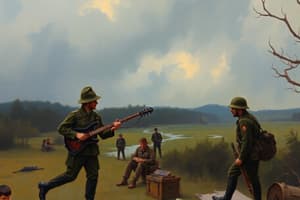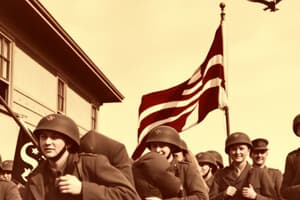Podcast
Questions and Answers
What was the primary purpose of U-boats during World War II?
What was the primary purpose of U-boats during World War II?
- To transport German troops to battle
- To destroy merchant ships from the Allies (correct)
- To carry out reconnaissance missions
- To conduct strategic air attacks
What was the main outcome of the Warsaw Ghetto uprising?
What was the main outcome of the Warsaw Ghetto uprising?
- The Jews achieved independence from Germany
- The Nazis intensified their efforts to suppress Jewish resistance (correct)
- The uprising led to peace between Jews and Germans
- The ghetto was expanded to accommodate more refugees
What event triggered Kristallnacht?
What event triggered Kristallnacht?
- A Polish-Jewish boy killing a German diplomat (correct)
- The declaration of war by the United States
- The invasion of Poland by Germany
- The establishment of Nuremberg laws
What was the significance of the MS St. Louis in 1939?
What was the significance of the MS St. Louis in 1939?
What was the Final Solution?
What was the Final Solution?
Which concentration camp was known for being a major extermination site?
Which concentration camp was known for being a major extermination site?
What restrictions did the Nuremberg Laws impose on Jews in Germany?
What restrictions did the Nuremberg Laws impose on Jews in Germany?
What condition existed in the Warsaw Ghetto that affected its inhabitants?
What condition existed in the Warsaw Ghetto that affected its inhabitants?
What was the primary function of the Wartime Prices and Trade Board during WW2 in Canada?
What was the primary function of the Wartime Prices and Trade Board during WW2 in Canada?
What was the significance of the National Resources Mobilization Act?
What was the significance of the National Resources Mobilization Act?
What were the Japanese Internment Camps in BC primarily a response to?
What were the Japanese Internment Camps in BC primarily a response to?
What was a key effect of the Conscription Crisis in Canada during WW2?
What was a key effect of the Conscription Crisis in Canada during WW2?
What was the purpose of sonar technology during World War II?
What was the purpose of sonar technology during World War II?
How did radar technology play a role in modern warfare?
How did radar technology play a role in modern warfare?
What was a significant medical advancement during WW2 that contributed to soldier recovery rates?
What was a significant medical advancement during WW2 that contributed to soldier recovery rates?
What is synthetic rubber noted for during and after World War II?
What is synthetic rubber noted for during and after World War II?
Flashcards
Wartime Prices and Trade Board
Wartime Prices and Trade Board
A Canadian government agency established during World War II to control prices and inflation, ensuring consumer protection.
National Resources Mobilization Act
National Resources Mobilization Act
A Canadian law passed during World War II to increase wartime production and support, both domestically and internationally.
Japanese Internment Camps
Japanese Internment Camps
Camps in British Columbia where Japanese Canadians were detained during World War II due to racial prejudice.
Conscription Crisis
Conscription Crisis
Signup and view all the flashcards
League Of Nations
League Of Nations
Signup and view all the flashcards
War Measures Act
War Measures Act
Signup and view all the flashcards
Sonar
Sonar
Signup and view all the flashcards
Radar
Radar
Signup and view all the flashcards
Code Conversion in WW2
Code Conversion in WW2
Signup and view all the flashcards
U-Boats
U-Boats
Signup and view all the flashcards
MS St. Louis
MS St. Louis
Signup and view all the flashcards
Ghettos
Ghettos
Signup and view all the flashcards
Kristallnacht
Kristallnacht
Signup and view all the flashcards
The Final Solution
The Final Solution
Signup and view all the flashcards
Auschwitz
Auschwitz
Signup and view all the flashcards
Nuremberg Laws
Nuremberg Laws
Signup and view all the flashcards
Study Notes
Wartime Government Policies
- Wartime Prices and Trade Board: Created to control prices and inflation in Canada during wartime, given the power to limit inflation, protecting consumers.
- National Resources Mobilization Act: Law passed to improve war planning for Canada's military efforts both overseas and domestically. Showcased government commitment to intensifying the war effort.
- Japanese Internment Camps (BC): Housing units for Japanese Canadians, often near abandoned mines or new government towns. Driven by racial discrimination and prejudice against Asians.
- Conscription Crisis (WW2): Political and military crisis resulting from mandatory military service, deeply dividing Canada and threatening political leaders.
- League of Nations (1920-1946): First intergovernmental organization aiming for international cooperation and peace. Created a new era of multilateralism.
Military Technology & Strategies
- SONAR: Sound navigating system used in WWII to locate submarines. Modern applications include nautical charting and shipwreck searches.
- RADAR: Electric system employing radio waves to detect objects; provides information on distance, position, size, shape, direction, and speed. Widely used today in air defense, marine radars, and more.
- Synthetic Rubber: Substance stronger than natural rubber used to improve aircraft windows, radar performance, and tank waterproofing. Modern uses in tires, building materials, and flooring.
- Medical Technology: Penicillin, antibiotics, and plastic surgery contributed to a 95% recovery rate for wounded Allied soldiers; advancements in technology are still happening and the virtual care industry has emerged.
- Enigma: German coding machine used in WWII to encrypt radio messages. Now rarely used.
- U-boats: German submarines intended to sink Allied merchant ships to disrupt their war efforts. Their attacks were pivotal in drawing the US into the war.
International Conflicts and Events of WW2 and Before
- MS St. Louis: German luxury liner carrying Jewish refugees fleeing Nazi Germany in 1939. Illustrates the anti-Semitic exclusion policies towards Jewish people.
- Warsaw Ghetto Uprising: Nazis confined Jews to ghettos with inadequate resources, leading to widespread starvation. The uprising saw thousands die in the Warsaw Ghetto which was a cramped area with horrible conditions with the ghetto being only 2.4% of Warsaw’s size.
- Kristallnacht (November 9-10, 1938): Coordinated attacks against Jewish communities in Nazi Germany and Austria, with synagogues being burned and an ordered 'pogrom'.
- Final Solution: Nazi plan to exterminate Europe's Jewish population (1941-1945), leading to the murder of ~6 million people in 21 countries. The plan was developed after Hitler became Chancellor on January 30, 1933.
- Auschwitz: Network of Nazi concentration and extermination camps during WWII. Located in Oświęcim, Poland, composed of Auschwitz I, Auschwitz II-Birkenau, Auschwitz III-Monowitz, and 45 satellite camps. Around 1.1 million prisoners are believed to have died at Auschwitz. The majority, 90%, were Jewish.
- Nuremberg Laws: Deprived Jews of citizenship and civil rights in Germany. Restricted Jewish interactions with non-Jews and limited social and economic opportunities. Jews could not marry non-Jews or hire Aryan women as maids and were also banned from public schools and owning land by 1936.
Studying That Suits You
Use AI to generate personalized quizzes and flashcards to suit your learning preferences.




